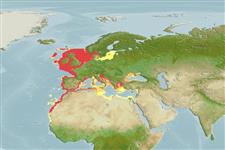Elasmobranchii (tubarões e raias) (sharks and rays) >
Carcharhiniformes (Ground sharks) >
Triakidae (Houndsharks) > Triakinae
Etymology: Mustelus: Latin for weasel, an ancient name for sharks, possibly referring to the pointed snouts, swift movements and/or rapacious feeding behavior of smaller predatory sharks [strictly not tautonymous with Squalus mustelus Linnaeus 1758 since type was designated by the ICZN]. (See ETYFish); asterias: Starry, referring to many small white spots on dorsal (upper) surface of body. (See ETYFish).
Environment: milieu / climate zone / depth range / distribution range
Ecologia
marinhas demersal; intervalo de profundidade 0 - 350 m (Ref. 6808). Temperate; 61°N - 16°N, 19°W - 36°E
Northeast Atlantic: British Isles and North Sea to Canary Islands, including the Mediterranean and Mauritania.
Comprimento de primeira maturação / Tamanho / Peso / Idade
Maturity: Lm 81.0, range 85 - ? cm
Max length : 154 cm TL macho/indeterminado; (Ref. 86318); peso máx. publicado: 4.8 kg (Ref. 4699)
A common inshore and offshore shark found on the continental and insular shelves from the intertidal down to at least 100 m. Prefers sandy and gravelly bottom. Feeds primarily on crustaceans (crabs, hermit crabs, lobsters and slipper lobsters). Ovoviviparous (aplacental), with 7 to 15 young per litter. Size at birth about 30 cm. Utilized fresh and dried salted.
Ovoviviparous, embryos feed solely on yolk (Ref. 50449).
Compagno, L.J.V., 1984. FAO Species Catalogue. Vol. 4. Sharks of the world. An annotated and illustrated catalogue of shark species known to date. Part 2 - Carcharhiniformes. FAO Fish. Synop. 125(4/2):251-655. Rome: FAO. (Ref. 244)
Status na Lista Vermelha da UICN (Ref. 130435)
Ameaça para os humanos
Harmless
Uso pelos humanos
Pescarias: espécies comerciais; peixe esportivo: sim
Ferramentas
Relatórios especiais
Baixar XML
Fontes da internet
Estimates based on models
Preferred temperature (Ref.
123201): 7 - 16.2, mean 10.1 °C (based on 587 cells).
Índice de diversidade filogenética (Ref.
82804): PD
50 = 0.5000 [Uniqueness, from 0.5 = low to 2.0 = high].
Bayesian length-weight: a=0.00170 (0.00143 - 0.00202), b=3.13 (3.08 - 3.18), in cm total length, based on LWR estimates for this species (Ref.
93245).
Nível Trófico (Ref.
69278): 3.6 ±0.3 se; based on diet studies.
Generation time: 7.5 ( na - na) years. Estimated as median ln(3)/K based on 2
growth studies.
Resiliência (Ref.
120179): Muito baixo(a), tempo mínimo de duplicação da população maior que 14 anos (tm=2-3; Fec=7).
Fishing Vulnerability (Ref.
59153): High to very high vulnerability (71 of 100).
Climate Vulnerability (Ref.
125649): Moderate to high vulnerability (49 of 100).
Nutrients (Ref.
124155): Calcium = 7.5 [2.7, 39.2] mg/100g; Iron = 0.16 [0.05, 0.62] mg/100g; Protein = 21.2 [18.8, 23.6] %; Omega3 = 0.236 [0.101, 0.548] g/100g; Selenium = 22.7 [7.0, 76.8] μg/100g; VitaminA = 6.69 [2.12, 20.78] μg/100g; Zinc = 0.428 [0.190, 0.861] mg/100g (wet weight);
